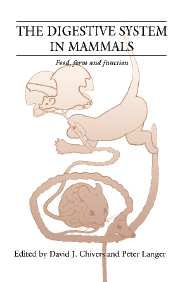Book contents
- Frontmatter
- Contents
- List of contributors
- Preface
- Part I Introduction
- Part II Food
- Part III Form
- Part IV Function
- 18 Foraging and digestion in herbivores
- 19 Gut morphology, body size and digestive performance in rodents
- 20 The integrated processing response in herbivorous small mammals
- 21 Digestive constraints on dietary scope in small and moderately-small mammals: how much do we really understand?
- 22 The effects and costs of allelochemicals for mammalian herbivores: an ecological perspective
- 23 Short-chain fatty acids as a physiological signal from gut microbes
- Part V Synthesis and perspectives
- Index
23 - Short-chain fatty acids as a physiological signal from gut microbes
Published online by Cambridge University Press: 18 March 2010
- Frontmatter
- Contents
- List of contributors
- Preface
- Part I Introduction
- Part II Food
- Part III Form
- Part IV Function
- 18 Foraging and digestion in herbivores
- 19 Gut morphology, body size and digestive performance in rodents
- 20 The integrated processing response in herbivorous small mammals
- 21 Digestive constraints on dietary scope in small and moderately-small mammals: how much do we really understand?
- 22 The effects and costs of allelochemicals for mammalian herbivores: an ecological perspective
- 23 Short-chain fatty acids as a physiological signal from gut microbes
- Part V Synthesis and perspectives
- Index
Summary
Many animal species depend on microbial activities in their digestive tract for a large part of their metabolic energy (Parra, 1978). Short-chain fatty acids (SCFA) such as acetic, propionic, butyric and valeric acids represent energy-carrying nutrients produced by gut fermentation (Bugaut, 1987).
These acids are major anions in the gut contents where fermentation takes place (Parra, 1978). The contribution of these acids to the host's energy economy varies among animals of different food habits. Nevertheless, all reptiles, birds and mammals possess some gut fermentation (Stevens, 1988). SCFA always exist at significant concentrations in gut fermentation chambers. Therefore, gut fermentation and the production of SCFA in the gut can be considered as part of the basic characteristics of land vertebrates.
Regulation of energy metabolism of ‘classic’ nutrients such as carbohydrates, proteins and lipids has been studied extensively. There are neural and humoral mechanisms that regulate the catabolism and anabolism of these nutrients to maintain their levels in the blood within an appropriate range. In contrast, relatively little is understood about regulatory mechanisms of energy metabolism involving SCFA, even though these acids are the main energy source in large herbivorous animals.
We humans, for instance, adjust our appetite according to blood sugar levels, which reflect the systemic energy balance. In other words, we have mechanisms to control the uptake of energy from classic nutrients. However, we do not know if we can control microbial activity based on the entry rate of SCFA into the host's body.
- Type
- Chapter
- Information
- The Digestive System in MammalsFood Form and Function, pp. 392 - 408Publisher: Cambridge University PressPrint publication year: 1994
- 2
- Cited by



